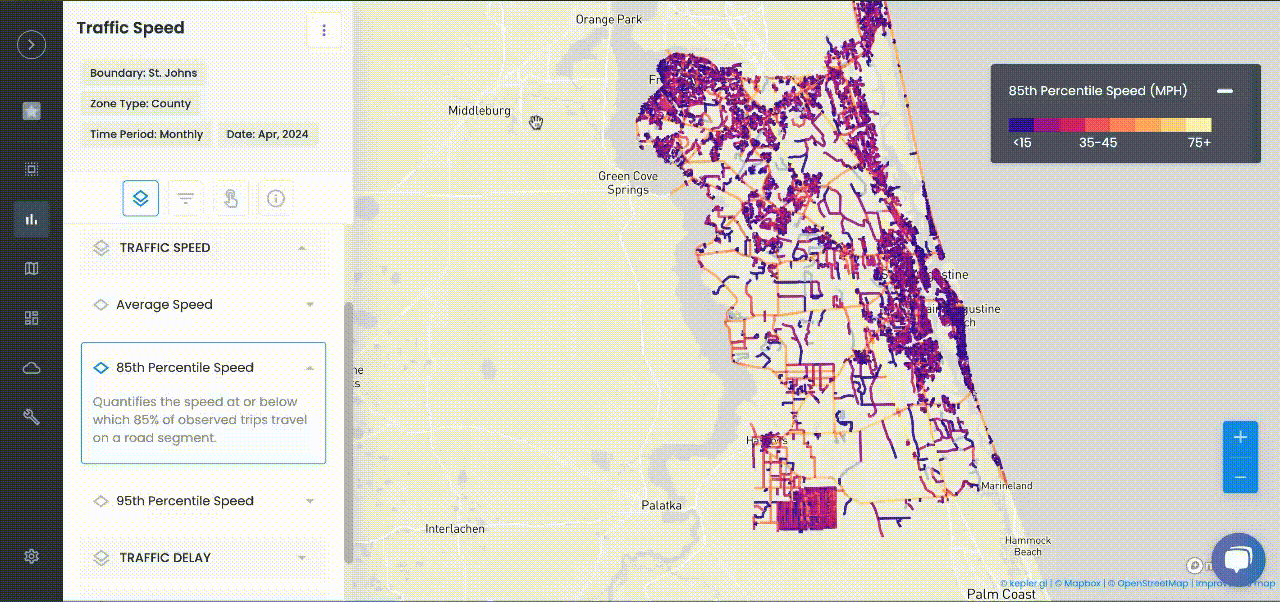
Congestion Management
Smart Traffic Intersections: How Sensors and AI Are Transforming Urban Traffic Flow
AI-powered smart intersections improve traffic flow, reduce delays, enhance safety, and help cities move smarter
What if traffic lights could think for themselves? That’s the power behind smart intersections—places where cameras, sensors, and AI work together to make city traffic smoother, safer, and faster. Unlike traditional signals that follow a fixed timer or basic car detection, smart intersections adjust in real time based on what’s actually happening on the road. They prioritize busy lanes, help pedestrians cross safely, and even give green lights to ambulances. In this blog, we’ll break down what smart intersections are, how they work, and how Urban SDK supports cities in getting the most out of them.
What Are Smart Intersections?
Smart intersections are modernized traffic signals that react to real-time road activity. Think of them as intersections with eyes (cameras), ears (sensors), and a brain (AI). Instead of sticking to rigid light cycles, they adjust traffic lights dynamically based on actual demand. If there’s a sudden wave of cars, they can extend green lights. If a pedestrian is waiting, they can trigger the walk signal faster.
Key components include:
- Advanced Detectors: Cameras, radar, LiDAR, and thermal sensors monitor traffic, pedestrians, and even visibility conditions.
- Edge Computing & AI: Small computers at the intersection run AI software to analyze traffic trends and adjust signals.
- Adaptive Signal Control: Traffic lights change based on live conditions instead of fixed schedules.
- Connectivity (V2X): Vehicles can “talk” to signals and vice versa, improving timing and prioritization for buses and emergency vehicles.
In essence, smart intersections use Internet of Things (IoT) tech and AI to constantly optimize traffic flow at key junctions.
How AI Improves Traffic Flow and Safety
1. Adaptive Signal Timing Reduces Congestion
AI helps reduce delays by adjusting green times based on actual traffic. In Pittsburgh, the SURTRAC AI system cut vehicle wait times by 40% and travel times by 25%. In Los Angeles, a citywide adaptive system saves 9.5 million driver hours annually. These systems respond to rush hour surges, special events, or traffic incidents by shifting light timing in real time. They can also create "green waves"—coordinated lights that let groups of cars move without stopping.
2. Pedestrian Detection and Safety
Smart intersections aren’t just for cars. Sensors detect people waiting to cross and activate the walk signal without needing a button press. If someone is slow to cross, the system can extend the red light to keep them safe. AI also helps prevent collisions between turning cars and people in the crosswalk by adjusting signal timing or using visual warnings.
New York City found pedestrian injuries dropped significantly after installing smart signals with automatic detection and smarter walk timing.
3. Emergency Vehicle and Transit Prioritization
Smart intersections can give priority to emergency responders and buses:
- Emergency Preemption: Ambulances get green lights ahead of time so they move through faster and safer.
- Transit Signal Priority (TSP): Buses can request extra green time if they’re behind schedule, helping them stay on time without disrupting other traffic.
Cities like Los Angeles and Nashville use TSP to improve public transit reliability, and some systems even prioritize carpools or high-occupancy vehicles.
4. V2X and AI Safety Alerts
Smart intersections can send alerts to connected vehicles:
- Warn drivers if they won’t make a light
- Alert cars of hidden pedestrians
- Reduce red-light running and near-misses
They can also monitor video for dangerous behaviors—like frequent sudden braking or cars not yielding to pedestrians—and help cities fix those problem spots before crashes occur.
Challenges and Considerations
1. Cost and Infrastructure Installing smart intersections requires sensors, cameras, processors, and communication systems—which can cost tens of thousands of dollars per site. But federal grants and affordable tech are making them more accessible.
2. Privacy and Security Cities must blur or avoid recording identifiable information, and protect these systems from hacking with encryption and secure architecture.
3. Technical Compatibility Smart intersections must use open standards so all vehicles and future tech can connect seamlessly.
4. Public Understanding People may notice green lights change at irregular times, or walk signs respond faster. Public education can help everyone understand and trust these changes.
Despite the challenges, more cities are adopting this tech. Pittsburgh, Los Angeles, Nashville, Seattle, and even entire countries like Singapore and China are using AI-powered intersections to cut delays, reduce emissions, and improve safety.
How Urban SDK Supports Smart Intersections
Urban SDK doesn’t control signals directly, but it plays a vital role in helping cities make sense of all the data smart intersections produce.
Here’s how Urban SDK helps:
- Data Integration: Combines traffic counts, travel times, crashes, and connected vehicle data into one dashboard.
- Near Real-Time Dashboards: Shows congestion, delay, speed, and volumes across the network, helping traffic teams spot and fix problems fast.
- Before/After Analysis: Compares past and current performance to measure improvements. Charts and maps make it easy to show results to stakeholders.
- Policy and Equity Alignment: Adds layers like school zones or low-income neighborhoods to ensure upgrades support citywide goals like Vision Zero or transit access.
Urban SDK becomes the “mission control” for smart traffic systems—making data understandable and actionable.
Conclusion
Smart intersections are the future of traffic control. By adjusting to real-time needs, they help cities cut congestion, improve safety, and move toward greener, more efficient streets. But to fully benefit, cities need tools to monitor, measure, and improve those systems. That’s where Urban SDK comes in.
Want to see how your city can make intersections smarter and safer? Contact Urban SDK for a demo. Our platform helps you integrate your traffic data, track performance, and make decisions that keep your roads moving—smarter and faster than ever before.
FAQs
Q1. What is a smart intersection and how does it work?
Ans: A smart intersection uses cameras, sensors, and AI to monitor real-time road activity, dynamically adjusting traffic lights to current conditions instead of fixed timers. This helps move vehicles and pedestrians more safely and efficiently through city streets.
Q2. How does AI improve traffic flow and reduce congestion at intersections?
Ans: AI-driven adaptive signal timing analyzes live traffic patterns, extending green lights for busy lanes and syncing signals to create “green waves.” Multiple cities like Pittsburgh and Los Angeles have reported up to 40% shorter wait times and millions of driver hours saved annually.
Q3. Can smart intersections make roads safer for pedestrians and cyclists?
Ans: Absolutely! Sensors detect people waiting to cross and can extend walk signals or trigger pedestrian lights automatically. This reduces accidents, as seen in New York City, where smart signals led to a significant drop in pedestrian injuries.
Q4. How do smart intersections help emergency vehicles and public transit?
Ans: These systems can prioritize green lights for ambulances, fire trucks, and buses, helping them move through the city faster and more safely - known as emergency preemption and transit signal priority.
Q5. What kind of data do smart intersections collect and how is it used?
Ans: They gather traffic volumes, vehicle speeds, pedestrian counts, and crash patterns, all of which can be visualized and analyzed with platforms like Urban SDK to track improvements and plan future upgrades.
Q6. What are the main challenges of implementing smart intersections in cities?
Ans: Major challenges include upfront infrastructure costs, privacy/security concerns, system compatibility, and the need for public education about how dynamic signals operate.
Q7. How does AI-enabled traffic management help cities achieve sustainability goals?
Ans: By reducing idle times, stop-and-go traffic, and emissions, smart signals help cities cut down on air pollution and energy use, directly supporting greener and more sustainable transportation networks.
Q8. Are smart traffic intersections secure and privacy-safe?
Ans: Modern systems anonymize commuter data and follow cybersecurity protocols to safeguard against misuse and privacy breaches, ensuring only non-identifiable data is used for traffic optimization.
Q9. Can smart intersection data help with citywide transportation planning?
Ans: Yes, the constant stream of data informs city planners about congestion hotspots, accident risk, and infrastructure needs - helping maximize returns on future investments and planning for smarter cities.
Q10. How does Urban SDK support cities with smart intersection technology?Ans: Urban SDK provides a unified dashboard to visualize, analyze, and monitor smart intersection performance, integrating traffic, safety, and equity metrics so city teams can make decisions quickly and confidently.

TRAFFIC ENFORCEMENT FEATURES
80% of citizen complaints
are a perception problem
Urban SDK provides precise hourly speed data to evaluate complaints and deploy resources efficiently for the greatest impact to public safety.
Urban SDK provides precise hourly speed data to evaluate complaints and deploy resources efficiently for the greatest impact to public safety.
Target Speeding
Identify hot spots, validate monthly speeding trends and monitor vulnerable areas like school zones.
Improve Safety
Crash and citations location information to compare speed trends month over month
Fast Response
Respond to citizen complaints sooner with address search and exportable reporting
Deploy Assets
Generate maps for traffic enforcement by time of day, location or division to deploy officers to known problem areas.
RESOURCES
Customer Success
See how public sector leaders succeed with Urban SDK.
WEBINAR
Identify speeding and proactively enforce issues
See just how quick and easy it is to identify speeding, address complaints, and deploy officers.







